RODEO: A GAME OF COWBOYS
Definition
Rodeo is a public performance or competition in which cowboys show their skill at riding cattle, wild horses and at catching cattle with ropes. There are 5 synonyms of the word rodeo, like festival, competition, enclosure, exhibition, and roundup.
In America, Rodeo at present is a spectator sport in which professional cowboy, cowgirls/showmen exhibit their skill and speed on horses and livestock in a series of contests in the standard events which are (i) calf roping (tie-down roping or team roping), (ii) bull riding, (iii) barrel racing, (iv) steer wrestling (or bulldogging), (v) steer roping (vi) saddle bronco riding, and (vii) bareback bronco riding. These are seven standard events in American rodeos while in some countries more events like back jumping, bullock riding, camp drafting, wild-cow milking, wild bullock & wild horse racings and flag & bending races, etc. etc. are also included.
In USA professional rodeos generally comprises on two types of events (i) the rough stock events and (ii) the timed events.
This game is very popular with cattle and horsemen, and they perform several events. Depending on sanctioning organization and region, other events such as breakaway roping, goat tying, and pole bending may also be a part of some rodeos. The “world’s first public cowboy contest” was held on July 4, 1883, in Pecos, Texas, between cattle driver Trav Windham and roper Morg Livingston.
Event Origin and Propagation
Rodeo is a competitive equestrian sport that arose out of the working practices of cattle herding in Spain and Mexico, expanding throughout the Americas and to other nations. During 16th century, the Spanish conquistadors and Spanish-Mexican settlers played a key role in the origin of rodeo with the introduction and propagation of horses and cattle in the southwest and ultimately it grew out in the cattle industry.
This term rodeo came from Spanish word “rodear” means “to surround” or “go around”, and this became common in American English about 1834 to denote a “round up” of cattle. Today the word is used primarily to refer to a public exhibition of cowboy skills, usually in the form of a
competitive event. Some anthropologists believe that rodeo is a blend of both performance and contest.
The Hispanic immigrants in USA used the rodeo process (i) to gather cattle for various purposes, (ii) moving them to new pastures, (iii) separating the cattle owned by different ranchers, (iv) or gathering in preparation for slaughter.
This evolved from these yearly gatherings where festivities were held, and horsemen could demonstrate their equestrian skills. It was this latter usage which was adopted into the cowboy tradition of the US and Canada. American rodeo, particularly popular today throughout the western United States, and in the Canadian province of Alberta, is the official state sport of Wyoming, South Dakota, and Texas. The iconic silhouette image of a “Bucking Horse and Rider” is a federal and state-registered trademark of the State of Wyoming.
The professional rodeos in US are governed and sanctioned by the PRCA (Professional Rodeo Cowboys Association) and WPRA (Women’s Professional Rodeo Association). The traditional season for competitive rodeo runs from spring through fall, while the modern season professional rodeo circuit runs longer, and concludes in December with the NFR (National Finals Rodeo) in Las Vegas, Nevada.
Animal Rights POV
It may be pointed out that some animal right and animal welfare activists consider the rodeo games as animal cruelty. Although there are strict standards for the selection, care and treatment of rodeo livestock, arenas, equipment requirements and specifications. Substantial improvements have been made in games to improve the animal welfare of rodeo animals including veterinary cover and other related regulations, however some states have put bans or restrictions on some events or equipment used during the play. Some countries have imposed ban or restrictions on the game like UK, Netherlands and some other nations.
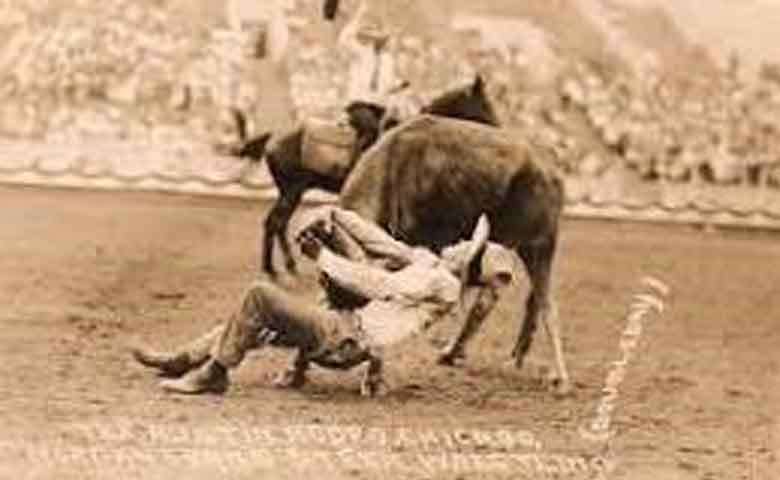
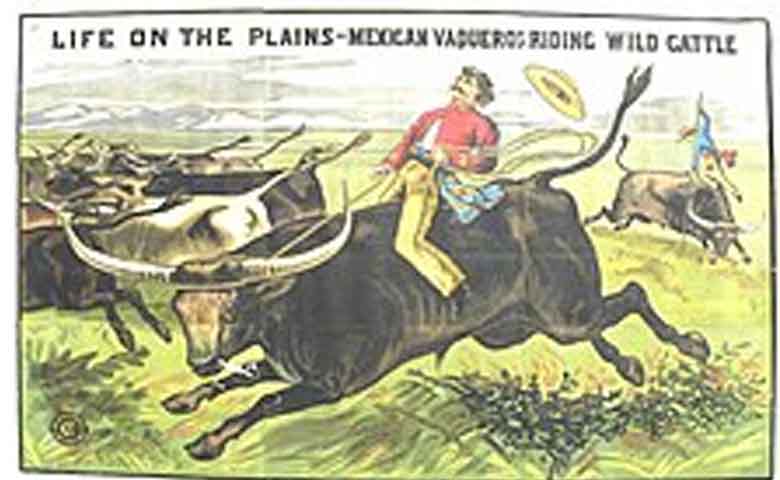
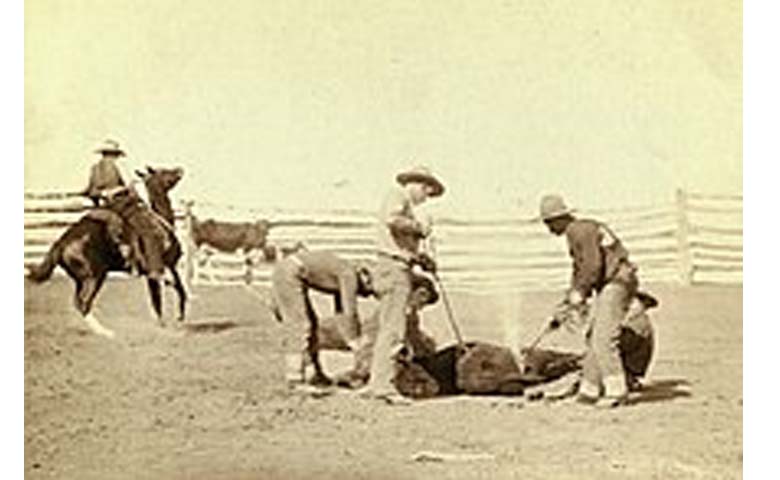
Development of Rodeo in USA
Many rodeo events were based on the tasks required by cattle ranching. The working cowboy developed skills to fit the needs of the terrain and climate of the American west, and there were many regional variations. Some of the skills required to manage cattle and horses date back to the 16th-century rodeo traditions of the Vaqueros in the lands of the Viceroyalty of New Spain, present day Mexico and the American Southwest. The first laws of the rodeo were established and implemented by Viceroy Luís de Velasco in 1551 in the Valley of Toluca in Central Mexico, to try and regulate cattle ranching in the region.
Early rodeo-like affairs of the 1820s and 1830s were informal events in the western US and northern Mexico with cowboys and vaqueros testing their work skills against one another. Following the American Civil War, rodeo competitions emerged, with the first held in Deer Trail, Colorado, in 1869.
Prescott, Arizona, claimed the distinction of holding the first professional rodeo, as it charged admission and awarded trophies in 1888. Between 1890 and 1910, rodeos became public entertainment, sometimes combined with Wild West shows featuring individuals such as Buffalo Bill Cody, Annie Oakley, and other charismatic stars. By 1910, several major rodeos were established in western North America, including the Calgary Stampede, the Pendleton Round-Up, and the Cheyenne Frontier Days.
On July 4, 1883, in the frontier town of Pecos, Texas, an argument between Trav Windham, a cattle driver, and Morg Livingston, an accomplished cattle roper, led to what the Encyclopedia Britannica refers to as the “world’s first public cowboy contest” and is often referred to as the first official rodeo. The two men chose to have the competition on the flatland on the west side of the Pecos River. The July 4th public holiday allowed ranchers, cowboys and townsfolk to attend. Many other ranchers and cowboys chose to take part in the event, including Jim Mannin, John Chalk, and Brawley Oates, many of whom traveled from distant ranches. Windham would end up winning the roping contest. Other winners include Pete Beard of Hashknife Ranch and Jeff Chism. Prize money was $40 and blue ribbons donated by a young resident.
Rodeo-type events also became popular for a time in the big cities of the eastern United States, with large venues such as Madison Square Garden playing a part in popularizing them for new crowds. There was no standardization of events for a rodeo competition until 1929, when associations began forming.
In the 1970s, rodeo saw unprecedented growth. Contestants referred to as “the new breed” brought rodeo increasing media attention. These contestants were young, often from an urban background, and chose rodeo for its athletic rewards. By 1985, one-third of PRCA members had a college education and as many as one-half of the competitors had never worked on a cattle ranch. Today, some professional rodeos are staged indoors in large, climate-controlled arenas and many are telecast. Other professional rodeos are held outdoors.
Numerous associations govern rodeo in the United States, each with slightly different rules and different events. The oldest and largest sanctioning body of professional rodeo is the Professional Rodeo Cowboys Association (PRCA) which governs about a third of all rodeos staged in the US annually. It was originally named the Cowboys Turtle Association, later became the Rodeo Cowboys Association, and finally the Professional Rodeo Cowboys Association in 1975. The PRCA crowns the World Champions at the National Finals Rodeo (NFR), in Las Vegas on the UNLV campus, featuring the top fifteen money-winners in seven events.
Women Participation in Rodeo
Historically, women have long participated in competitive rodeo. Prairie Rose Henderson debuted at the Cheyenne rodeo in 1901, and, by 1920, women were competing in rough stock events, relay races and trick riding. But after Bonnie McCarroll died in the Pendleton Round-Up in 1929 and Marie Gibson died in a horse wreck in 1933, women’s competitive participation was curbed. Rodeo women organized into various associations and staged their own rodeos. Today, women’s barrel racing is included as a competitive event in professional rodeo, with breakaway roping and goat tying added at collegiate and lower levels. They compete equally with men in team roping, sometimes in mixed-sex teams. Women also compete in traditional roping and rough stock events at women-only rodeostis, pulvinar dapibus leo.
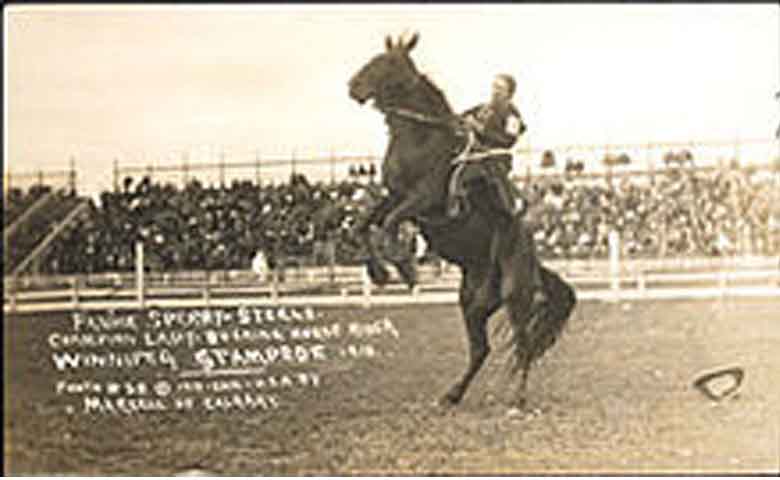
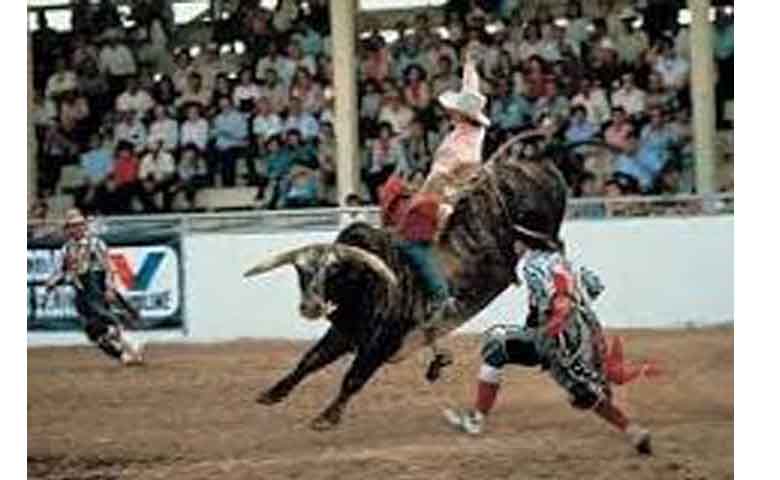
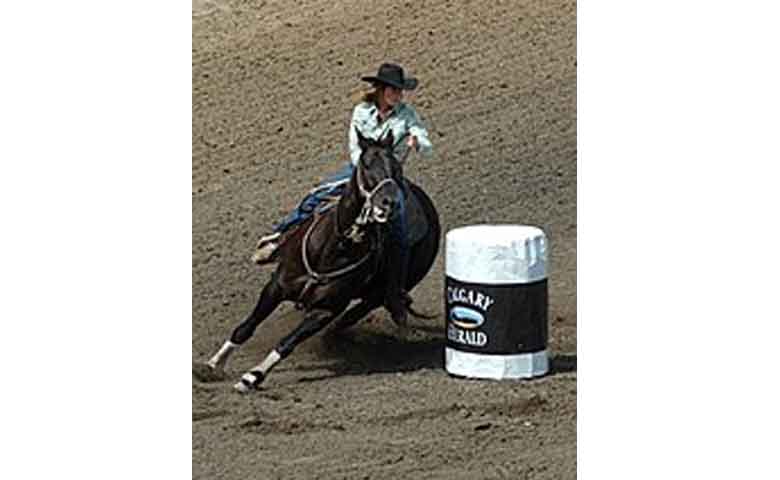
Fannie Sperry Steele
Champion Lady Bucking Horse Rider, Winnipeg Stampede, 1913
Barrel racing
Timed events included are Roping
Roping competitions are based on the tasks of a working cowboy, who often had to capture calves and adult cattle for branding, medical treatment and other purposes. The cowboy must throw a type of rope with a loop, known as a lariat, riata or reata, or lasso, over the head of a calf or onto the horns and around the hind legs of adult cattle, and secure the animal in a fashion dictated by its size and age.
Calf roping, also called tie-down roping, is based on ranch work in which calves are roped for branding, medical treatment, or other purposes. It is the oldest of rodeo’s timed events.
Breakaway roping is a form of calf roping where a very short lariat is used, tied lightly to the saddle horn with string and a flag. When the calf is roped about the neck, the horse stops, the flagged rope breaks free of the saddle, and the calf runs on without being thrown or tied.
Team roping, also called “heading and heeling”, is the only rodeo event where men and women riders compete together. Two people capture and restrain a full-grown steer. One horse and rider, the “header”, lassos a running steer’s horns, while the other horse and rider, the “heeler”, lassos the steer’s two hind legs. Once the animal is captured, the riders face each other and lightly pull the steer between them, so that both ropes are taut. This technique originated from methods of capture and restraint for treatment used on a ranch.
Other timed events
Barrel racing is a timed speed and agility event. In barrel racing, horse and rider gallop around a cloverleaf pattern of barrels, making agile turns without knocking the barrels over. In professional, collegiate and high school rodeo, barrel racing is an exclusively women’s sport, though men and boys occasionally compete at local O-Mok-See competition.
Steer wrestling, also known as bulldogging, is a rodeo event where the rider jumps off his horse onto a Corriente steer and wrestles it to the ground by grabbing it by the horns. This is probably the single most physically dangerous event in rodeo for the cowboy, who runs a high risk of jumping off a running horse head first and missing the steer, or of having the thrown steer land on top of them, sometimes horns first.
Goat tying is usually an event for women or pre-teen girls and boys; a goat is staked out while a mounted rider runs to the goat, dismounts, grabs the goat, throws it to the ground and ties it in the same manner as a calf. The horse must not come into contact with the goat or its tether.
“Rough stock” competition
In spite of popular myth, most modern “broncs” are not in fact wild horses but are more commonly spoiled riding horses or horses bred specifically as bucking stock. Rough stock events also use at least two well-trained riding horses ridden by “pick up men” (or women), tasked with assisting fallen riders and helping successful riders get safely off the bucking animal.
Bronc riding – there are two divisions in rodeo, bareback bronc riding, where the rider is only allowed to hang onto a bucking horse with a type of surcingle called a rigging; and saddle bronc riding, where the rider uses a specialized western saddle without a horn (for safety) and hangs onto a heavy lead rope, called a bronc rein, which is attached to a halter on the horse.
Bull riding is an event where the cowboys ride full-grown bulls instead of horses. Although skills and equipment similar to those needed for bareback bronc riding are required, the event differs considerably from horse riding competition due to the danger involved. Because bulls are unpredictable and may attack a fallen rider, rodeo clowns, now known as “bullfighters”, work during bull-riding competition to distract the bulls and help prevent injury to competitors.
Steer riding is a rough stock event for boys and girls where children ride steers, usually in a manner similar to bulls. Ages vary by region, as there is no national rule set for this event, but generally participants are at least eight years old and compete through about age 14. It is a training event for bronc riding and bull riding.
Rules of the Game
Formal associations and detailed rules came late to rodeo. Until the mid-1930s, every rodeo was independent and selected its own events from among nearly one hundred different contests.
Apart from these traditionally-sanctioned events some fewer common events are also part of the Rodeo like steer roping, steer tripping, steer daubing, steer wrestling, pole bending, chute dogging, trick riding, and wild cow milking, etc. Due to the danger of some injuries, potential risks and animal cruelty, a few countries have imposed bans on whole games, while some restrict certain activities/practices in the game.
Other common events
Several other events may be scheduled on a rodeo program depending upon the rodeo’s governing association. The Professional Bull Riders (PBR) is a more recent organization dedicated solely to bull riding. Rodeo gender bias was a problem for cowgirls, and in response women formed the Girls Rodeo Association in 1948 (now the Women’s Professional Rodeo Association (WPRA) and held their own rodeos. The WPRA is open exclusively to women. Women’s barrel racing is governed by the WPRA, which holds finals for barrel racing along with the PRCA with the cowboys at the NFR. There are associations governing children’s, teen, and college level rodeos as well as associations governing rodeo for gays, seniors, Native Americans and others.
There are also high-school rodeos, sponsored by the National High School Rodeo Association (NHSRA). Many colleges, particularly land grant colleges in the west, have rodeo teams. The National Intercollegiate Rodeo Association (NIRA) is responsible for the College National Finals Rodeo (CNFR) held each June in Casper, WY. Other rodeo governing bodies in the United States include American Junior Rodeo Association (AJRA) for contestants under twenty years of age; National Little Britches Rodeo Association (NLBRA), for youths ages five to eighteen; Senior Pro Rodeo (SPR), for people forty years old or over; and the International Gay Rodeo Association. Each association has its own regulations and its own method of determining champions. Athletes participate in rodeos sanctioned by their own governing body or one that has a mutual agreement with theirs and their points count for qualification to their Association Finals. Rodeo committees must pay sanctioning fees to the appropriate governing bodies, and employ the needed stock contractors, judges, announcers, bull fighters, and barrel men from their approved lists. Other nations have similar sanctioning associations.
Prize Money for Rodeo Stars
Until recently, the most important was PRCA, which crowns the World Champions at the National Finals Rodeo (NFR), held since 1985 at Las Vegas, Nevada, featuring the top fifteen money-winners in seven events. The athletes who have won the most money, including NFR earnings, in each event are the World’s Champions. However, since 1992, Professional Bull Riders, Inc. (PBR) has drawn many top bull riders, and holds its own multimillion-dollar finals in Las Vegas prior to the NFR. Women’s barrel racing is governed by the WPRA and holds its finals along with the PRCA with the cowboys at the NFR.
Contemporary rodeo is a lucrative business. More than 7,500 cowboys compete for over thirty million dollars at 650 rodeos annually. Women’s barrel racing, sanctioned by the WRPA, has taken place at most of these rodeos. Over 2,000-barrel racers compete for nearly four million dollars annually. Professional cowgirls also compete in bronc and bull riding, team roping and calf roping under the auspices of the PWRA, a WPRA subsidiary. However, numbers are small, about 120 members, and these competitors go largely unnoticed, with only twenty rodeos and seventy individual contests available annually. The total purse at the PWRA National Finals is $50,000. Meanwhile, the PBR has 700 members from three continents and ten million dollars in prize money to these rodeo stars.
Dr Muhammad Younas
Subject Expert at LM, FAH, UAF
myounas07@gmail.com